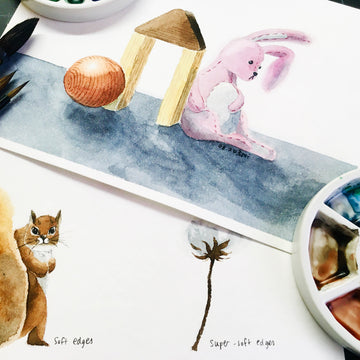When envisioning the skill set of a watercolourist, being a master of edges may not be the first thing you'd place on the list! You may be surprised, then, to discover the importance of edges in watercolour.
When we talk of edges, we’re referring to more than the shape we’re painting. To be more specific, an edge can be hard or soft.
Watercolour is one of the easier media to achieve the edge you need, so let’s take a closer look at these edges and how they affect a painting’s tone and mood.
Material Benefits
First off, from the two adjectives, you can probably tell right off the bat that they have something to do with material properties.
For example, a pillow is “soft”, while a rock is “hard”. In a similar way, you can use edges to give what you’re painting the illusion of these properties.
It’s also possible to use a certain type of edge and push it to the extreme, which will affect the overall style and mood of a painting. But let’s start with the basics!
Soft Edges

There are two ways to create a soft edge. One is to paint the shape of your object, and before the paint dries, take a clean brush and gently run it across the edge that needs to be softened.
Not only does it lighten the paint (as essentially, you’re using your paintbrush to absorb paint along the edge), but it also creates a slight gradient effect.
This method works well for painting fluffy things, as the extra fuzz gives it that “plush” feel. It’s also good for painting distant landscapes, as you can make features like faraway mountains fade into the background.

The other method is to wet the paper with clean water before adding paint on the wet surface. This is the more extreme version of a soft edge, as the paint spreads much more.
It’s also more difficult to control, so you might have to let the watercolour just do its thing!
You can also get really great and smooth blends with this method, which is great for things without a defined edge, such as cotton balls, clouds, or even a blurry background.
Wanna practise your soft edges? Try your hand at painting some clouds in watercolour!
Hard Edges

These are great for painting “edgy” things! I’m talking literal edges here, such as rocks, crystals, or anything that has a defined edge.
To paint a hard edge, just put your paint straight onto paper, and voila! There’s your hard edge.
It’s a lot easier to control the paint with this method, and you can even add details, such as painting the silhouette of a building.
This edge is more commonly found in painting structures and rigid objects in general, but I know some artists use it as part of their style (most notably comic book artists and illustrators).
Softer edges can be used too, though you’ll usually find a mixture of both techniques within the same watercolour artwork.
Useful Shadows

Another way to really make use of edges is when painting shadows.
They not only reflect the weather and the time of day, but also the shape, hardness, and texture of the object casting and receiving the shadow!
I’ve demonstrated with several objects and shadows above to show how you can really make good use of both hard and soft edges to suggest different material properties and time of day.
In fact, it’s a good idea to utilise both types of edges in any painting, as it’s the contrast between them that make the other stand out – a definite complementary pair of techniques.
Edging Onward

At the end of the day, it does take a bit of observation, experimentation, and practice to know which type of edge to use for which situation.
Ultimately, as the artist, you could override the “rules” for the sake of having a certain style, such as a softer, more whimsical style, or a clean and clear-cut style.
It’s good to know your options though, and in any case, I hope this article has been useful for you and your journey as an artist!
Does your painting style lean more towards hard or soft edges? Or do you prefer having a balanced mixture of both? Let us know in the comments below!


